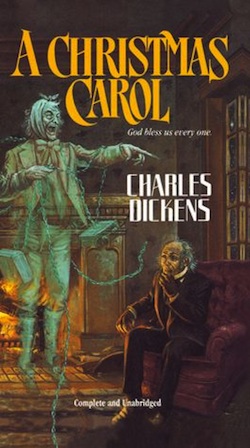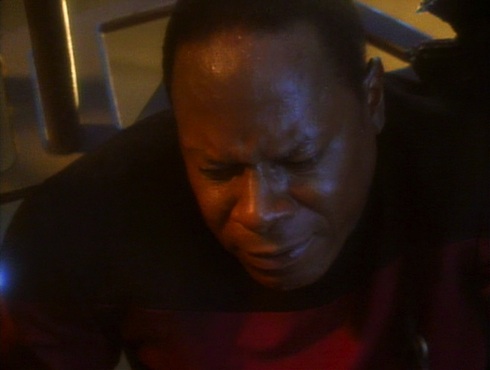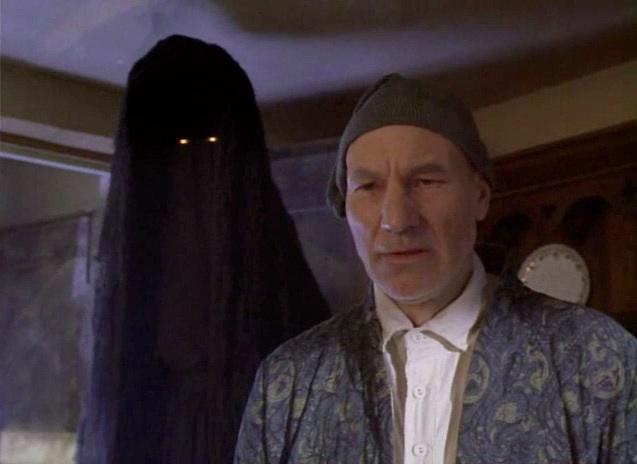In the afterward to a 1988 edition of Charles Dickens’ A Christmas Carol, Jane Yolen points out this was not the only attempt at a yuletide tale from the famous author. She mentions the four others: The Chimes, The Cricket On the Hearth, The Battle of Life and The Haunted Man. Most of us have never heard of these stories. And there’s a reason for that. Yolen says:
They never caught on the way the first story did. They lack the universality of A Christmas Carol, its range, its zest. A Christmas Carol was not written for children, but rather for an adult or family audience.
Notably, it also features time travel, 52 years prior to the publication of The Time Machine by H.G. Wells. This sort of time-travel, along with the special Dickens-brand of ghosts has given the genre of science fiction a handy and mutable thematic structure, which pops up in everything from Kurt Vonnegut to Deep Space Nine.
Between Muppets, Patrick Stewart, Bill Murray and all the other different interpretations of this famous story, it’s easy to forget how much the original Dickens text sucks you in. Pick up a copy tomorrow and try not to be totally captivated by the easy prose and meta-fictional chattiness of the Dickens voice. Right at the beginning, the author/narrator blatantly compares what is going down to Hamlet and practically shakes the reader by the shoulders to make plain that Marley is really really dead. Really!
If we were not perfectly convinced that Hamlet’s father died before the play began, there would be nothing more remarkable in his taking a stroll at night, in an easterly wind, upon his own ramparts, than there would be in any other middle-aged gentleman rashly turning out after dark in a breezy spot- say Saint Paul’s Churchyard for instance-literally to astonish his son’s weak mind.
 This isn’t a weird introduction to the story written by Dickens in his own voice. Instead, this appeal to think about why Hamlet works is IN the novella. It’s effective, but also, when you take a second to think about the brazenness, it’s also hilarious. A Christmas Carol is not a comedy by any means, but there is a bit a wink-wink-nudge-nudge to the over-the-top cruelty of Scrooge in the opening pages. No wonder people were inspired to write corny songs about this guy. He’s a cartoon character. However, by the time Marley departs, the reader will likely have developed some sympathy for the old miser, simply because-unlike film or theatre versions- we’re privy to what’s going on in Scrooge’s brain. He’s scared and in denial from the very first scene, making faux-critical statements of the world around him, while internally in pain. For me, this makes his overall transformation not one of a beast becoming a saint, but more like a cowardly turtle slowing poking its head out and then growing wings.
This isn’t a weird introduction to the story written by Dickens in his own voice. Instead, this appeal to think about why Hamlet works is IN the novella. It’s effective, but also, when you take a second to think about the brazenness, it’s also hilarious. A Christmas Carol is not a comedy by any means, but there is a bit a wink-wink-nudge-nudge to the over-the-top cruelty of Scrooge in the opening pages. No wonder people were inspired to write corny songs about this guy. He’s a cartoon character. However, by the time Marley departs, the reader will likely have developed some sympathy for the old miser, simply because-unlike film or theatre versions- we’re privy to what’s going on in Scrooge’s brain. He’s scared and in denial from the very first scene, making faux-critical statements of the world around him, while internally in pain. For me, this makes his overall transformation not one of a beast becoming a saint, but more like a cowardly turtle slowing poking its head out and then growing wings.
My favorite bit, which seems to get lost in our recollection of A Christmas Carol, occurs when The Ghost of Christmas Past has deposited Scrooge into his boyhood. In this scene, Scoorge grows zits because the time-travel starts de-aging him. It’s a sweetly awkward notion, and also ridiculously creative. You can almost see Dickens sitting around thinking up this conceit: “Under what circumstance, other than adult on-set acne, could I get a bunch of zits on my cheek? I know! Time Travel!”
And here’s where Dickens created a science fiction monster. What is A Christmas Carol really about? Certainly not the religious holiday, nor the secular perception. Sure, Christmas is a handy device, lending the story a little more emotional weight, but really, it’s neither here nor there. A Christmas Carol is simply a story about a person having an epiphany, specifically an epiphany brought on by time travel. Sound familiar? If you pull off all the holly and wrapping paper it’s a similar conceit to Slaughterhouse Five.
Now, can I prove Vonnegut was directly influenced by Dickens? Not really. With all the time travel literature floating around out there, it might seem like a stretch at first. However, here’s something else to consider: In A Christmas Carol a lot of why Scrooge is “broken” comes from his inability to get his act together with his fiancé Belle. The end of this engagement is a huge scar in Scrooge’s life. Maybe it’s not as horrific as the firebombing of Dresden, but it is big enough of a deal to explain the pathology of the character.

Leaving Vonnegut alone for a second, there’s a slightly easier pop-culture analog. In the very first episode of Star Trek: Deep Space Nine, the aliens living in the wormhole move Ben Sisko throughout various parts of his life. Though they don’t take him into the future, they do depict the present and the past with brutal accuracy. The Scrooge thing is pretty clear: Sisko is an angry bitter person who cusses out Captain Picard and generally wines about being stuck on a crumby space station. He’s also super depressed about his wife dying years prior. Sisko “exists” in the moment in which Jennifer died, similar to the way Scrooge turns into an asshole after Belle leaves him. It’s only by letting go of the past, and embracing the good people around them in the present that both Sisko and Scrooge can move on and change for the better.
Star Trek gives us another Scrooge-like epiphany in the mega-famous Next Generation finale “All Good Things…” Here, The Ghost of Christmas Everything-Q-takes Picard from past, present, and future, in order to show him how lame humanity really is. The epiphany Picard is forced to have in this story isn’t necessarily a personal one, but instead an intellectual one; Q wants him to think about time differently. When he accomplishes this, Picard’s a more enlightened person. Still, like Scrooge, a moral character choice is made by Picard at the end of this episode. He finally decides to hang out with his crew and play poker, instead of hiding in his ready room like an old miser.
From The Time Traveler’s Wife to last years’ Doctor Who Christmas Special, the notion of characters gaining unique perspectives through guided time-travel are as ubiquitous as Christmas music playing in American shopping malls. Time travel is at its best when it helps characters figure out not only who they are, but also who they’ve been and who they could be. Dickens’ A Christmas Carol is still the shining example of the best kind of time travel story. And while many have called Dickens “the man who discovered Christmas” I think it’s safe to say Dickens is the man who discovered time travel.
Ryan Britt is the staff writer for Tor.com. He is the creator and curator of Genre in the Mainstream.










